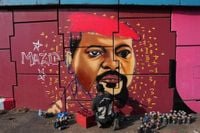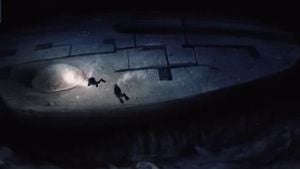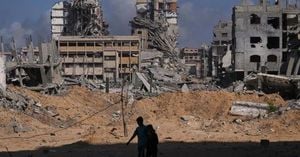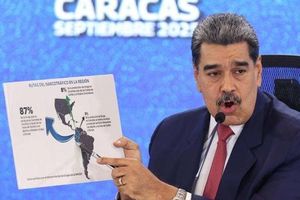In the bustling streets of Conakry, Guinea’s capital, a vibrant transformation is underway—one that’s as much about shifting public perception as it is about splashing color on concrete. The agent of this change? Omar Diaw, a Senegalese artist whose journey from his native Dakar to the heart of Guinea has turned city walls into sprawling canvases of history, culture, and hope.
It’s hard to believe that less than a decade ago, graffiti in Conakry was widely dismissed as nothing more than vandalism. According to the Associated Press, Diaw recalls, “It was thought that graffiti was vandalism.” But where others saw trouble, Diaw saw opportunity. With a gentle persistence, he set out to win over the city—one mural at a time.
When Diaw, who also goes by the artist name “Chimere” (French for chimera), arrived in Guinea in 2018, the city’s walls were mostly blank, untouched by the bold strokes that had long defined urban landscapes in Senegal. There, graffiti had already flourished, with Dakar serving as the launchpad for West Africa’s street art movement since the late 1980s. In Conakry, however, the art form was still in its infancy.
“We had to seduce the population,” Diaw explained to AP reporters, emphasizing that his approach was rooted in public service. Instead of clandestine tags, he opted for murals with clear, positive messages. One of his first projects was a public awareness campaign about COVID-19 preventive measures—a timely effort that resonated with a city grappling with the challenges of rapid urbanization and public health concerns.
As Diaw and his fellow artists—sometimes unloading dozens of paint cans onto the roadside—began work, something remarkable happened. Civilians and police alike watched without protest. “They know who I am,” Diaw said, reflecting a growing acceptance that would have been unthinkable years before.
Diaw’s murals are hard to miss. Towering images of famous Guinean musicians and African independence leaders loom over the city’s crowded streets, dwarfing even the overloaded trucks that rumble by. The portrait of Samory Toure, the legendary West African resistance fighter, is so integrated into daily life that drying laundry now hangs above it. His collective’s tag—Guinea Ghetto Graff—is visible in neighborhoods across the city, a testament to the movement’s reach.
The roots of this artistic revolution trace back to Dakar, Senegal, in 1988. There, Amadou Lamine Ngom—known as “Docta”—became the region’s first graffiti artist. Ngom and his peers were soon commissioned to paint murals for public campaigns, like cleaning up Dakar’s streets. In those early days, Ngom mostly worked at night, wary of public and official scrutiny. But he soon changed tack. “I decided to do it in broad daylight,” Ngom told AP. “So as not to copy what’s happening in the United States, Europe or elsewhere. To create graffiti that resembles the African reality, taking into account our reality, our values.”
Ngom’s mentorship proved pivotal for a teenage Diaw, who grew up sketching and drawing from the age of eight. Diaw’s own words capture the spirit of his journey: “All [my] life has been spiritual gymnastics to reach the heights of art through drawing and painting.” By the mid-2000s, Diaw had embraced a mixed technique, combining painting with the large-scale impact of graffiti. He joined the RBS crew, participated in major Senegalese graffiti festivals like Festi Graff and Art Mur, and honed signature styles such as “wildstyle,” “bloc letter,” and “bubble.”
But it’s in Guinea that Diaw’s vision has truly blossomed. As leader of the Guinea Ghetto Graff collective and co-organizer of the country’s premier graffiti festival, Lassiry Graffiti, he’s brought together a new generation of artists and elevated graffiti from the shadows into the city’s spotlight. His murals don’t just beautify—they educate and uplift. Whether celebrating pan-African heroes, raising awareness about tropical diseases, or commemorating Guinea’s President Mamadi Doumbouya (who took power in a 2021 coup), Diaw’s work is deeply rooted in community and history.
Conakry’s governor has taken notice, giving Diaw carte blanche to paint wherever he chooses. This official support is a far cry from the skepticism that once greeted street art in the city. As Ngom observed, “With the public’s backing, the authorities didn’t have a choice.” The cityscape now bears witness to this shift, with Diaw’s murals becoming landmarks in their own right.
The impact of these murals is felt not just in government offices or art circles, but on the streets themselves. Ousmane Sylla, a 22-year-old driver, shared his appreciation with AP: “It reminds us of old Guinean musicians. It reminds us of history. Graffiti is good for Africa, it’s good for this country, it’s good for everyone. I like it, and it changed the face of our city.”
Yet, for all the progress, Diaw and his peers know there’s more to be done. The next frontier? Inclusion. Mama Aissata Camara, one of the few women on Guinea’s graffiti scene, voiced a hope shared by many: “I would really like to see more women become a part of this, because they say that (graffiti) is for men.” Diaw, for his part, continues to teach and mentor young people, eager to see the movement become even more representative of the city it serves.
Graffiti in Senegal has taken on an increasingly assertive role, especially in political messaging around anti-government protests. In Guinea, Diaw’s work has addressed complex topics like migration, blending realism with quick, clear messaging. The medium’s evolution—from nighttime acts of rebellion to daylight celebrations of African identity—mirrors broader social changes across West Africa.
For Diaw, the mission is as much about celebration as it is about activism. Identifying as a pan-African artist, he uses his talent to honor black culture and history, believing that the walls of Conakry can serve as both canvas and classroom. As his latest mural—depicting current president General Mamadi Doumbouya—took shape beside a busy thoroughfare, passersby paused to admire, reflect, and perhaps, to hope.
In the end, the story of Omar Diaw and Conakry’s street art renaissance is one of transformation: of walls, of minds, and of a city that’s learning to see itself anew.




